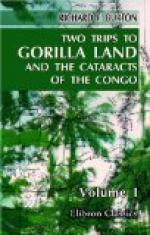Chapter XI.
Mr., Mrs., and Master Gorilla.
The reader will kindly bear in mind, when perusing my notes upon the gorilla, that, as in the the case of the Fan cannibalism described by the young French traveller, my knowledge of the anthropoid is confined to the maritime region; moreover, that it is hearsay, fate having prevented my nearer acquaintance with the “ape of contention.”
The discovery must be assigned to Admiral Hanno of Carthage, who, about B. C. 500, first in the historical period slew the Troglodytes, and carried home their spoils.
The next traveller who described the great Troglodytes of equatorial Africa was the well-known Andrew Battel, of Leigh, Essex (1589 to 1600); and his description deserves quoting. “Here (Mayombo) are two kinds of monsters common to these woods. The largest of them is called Pongo in their language, and the other Engeco “(in the older editions “Encego” evidently Nchigo, whilst Engeco may have given rise to our “Jocko"). “The Pongo is in all his proportions like a man, except the legs, which have no calves, but are of a gigantic size. Their faces, hands, and ears are without hair; their bodies are covered, but not very thick, with hair of a dunnish colour. When they walk on the ground it is upright, with their hands on the nape of the neck. They sleep in trees, and make a covering over their heads to shelter them from the rain. They eat no flesh, but feed on nuts and other fruits; they cannot speak, nor have they any understanding beyond instinct.
“When the people of the country travel through the woods, they make fires in the night, and in the morning, when they are gone, the Pongos will come and sit round it till it goes out, for they do not possess sagacity enough to lay more wood on. They go in bodies, and kill many negroes who travel in the woods. When elephants happen to come and feed where they are, they will fall on them, and so




